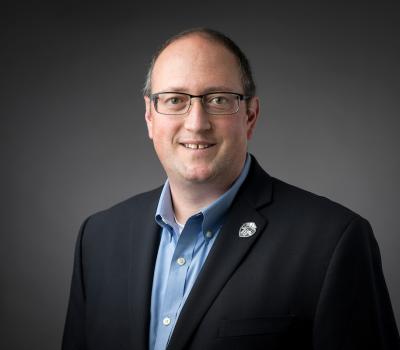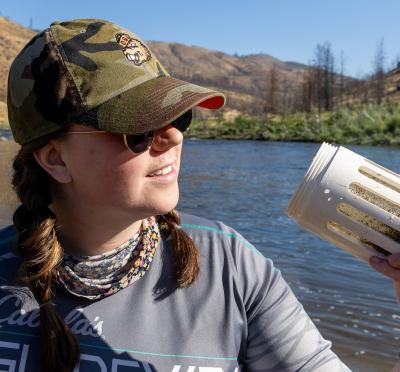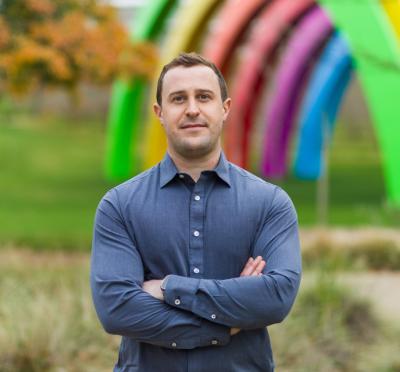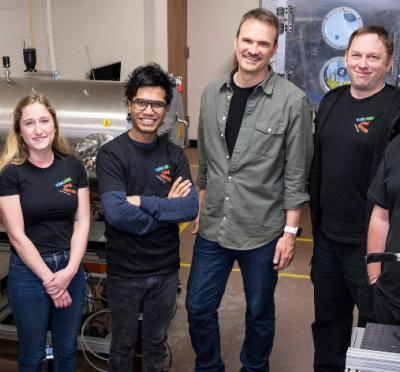As he was closing in on his Ph.D. and applying for academic positions, David Hurwitz received an offer from the College of Engineering at Oregon State University that was too good to pass up.
“I would get to do the type of research I most enjoyed — traffic safety and operations with an emphasis in transportation human factors — and I would be able to build a type of laboratory that’s rare in the civil engineering domain,” said Hurwitz, professor of transportation engineering, director of the Driving and Bicycling Simulator Laboratory, and director of the Kiewit Center for Infrastructure and Transportation.
There was another, unexpected draw: the students.
“I remember the exceptional quality of the students I met when I visited campus,” he said. “Their knowledge, attitude, and passion really impressed me.”
Once Hurwitz settled into his routine as a new assistant professor in 2009, he realized, a bit to his surprise, how much he enjoyed teaching and mentoring students.
Judging by the list of awards he’s won for teaching and mentoring from Oregon State and from professional engineering societies — about a dozen so far — he’s become pretty good at it. Among the most significant, he says, is the Wilbur S. Smith Distinguished Transportation Educator Award, presented by the Institute of Transportation Engineers.
Beyond the classroom, most of Hurwitz’s student interactions occur through the Hurwitz Research Group, which operates the Driving and Bicycling Simulator Lab, located in the O.H. Hinsdale Wave Laboratory, and conducts research addressing a range of transportation-related issues, including pedestrian safety, human factors, and traffic control. Since Hurwitz joined he university, more than 90 undergraduate, master’s, and doctoral students have passed through the group.
Jane Weber, a doctoral student in transportation engineering, hadn’t planned to be among them for long. With a single quarter remaining before graduating with a bachelor’s degree in 2020, Weber needed to fill one research credit. Some friends suggested that she ask Hurwitz, so she emailed him to inquire about joining his group as a research assistant.
“He was very enthusiastic about having me become part of the team,” Weber said. Weber — who was on the verge of becoming the first in her family to earn a college degree — expected to graduate and then join the workforce. Years earlier, she had harbored a dream about earning a Ph.D., but the notion seemed unrealistic and beyond her reach. Hurwitz saw things differently.
“He gave me encouragement throughout that one quarter, and he helped me see that going to graduate school was really possible. It revived a childhood dream,” she said.
Through her research, Weber aims to determine which methods of removing old roadway lane markings are most effective. Residual and unnecessary markings can cause confusion among drivers about what lane they should be in.
Weber’s experience reflects a similar event from Hurwitz’s college days. In his third year as an undergraduate at the University of Massachusetts and unsure of the academic path he wanted to take, he asked one of his professors, Kathleen Hancock, if he could join her lab as a research assistant. She agreed, and the first project involved analyzing data from a driving simulator to determine the effects of low levels of alcohol on the performance of younger drivers. “After that, I was hooked on transportation research,” Hurwitz said.
“I’m also a huge believer in paying opportunities forward, so I try to give students as many opportunities as I can to do meaningful work.”
Dylan Horne, Ph.D. civil engineering ’19, a transportation engineer for the town of Chapel Hill, North Carolina, earned their master’s degree from North Carolina State University in 2015. Then they embarked on a cross-country bike ride, stopping along the way to meet with faculty at several civil engineering doctoral programs. After rolling into Corvallis, they met Hurwitz for lunch. (Soon after, Horne rode back to North Carolina to complete their six-month, 7,000-mile odyssey.)
“Dave is the main reason I chose Oregon State for my Ph.D.,” Horne said. “It’s not just because his research on bicycle and road safety interested me, but also because of his willingness to offer me a fellowship so I didn’t have to worry about finances after moving across the country. He was always available and always willing to listen. And the sense of teamwork and camaraderie in the research group was unparalleled.”
“He really enjoyed teaching,” said Ellie Simpson, M.S. civil engineering ’18, a transportation engineer in the Portland office of HDR, a global engineering company. “His lessons were well thought out and delivered in a way that everyone could understand. As my advisor, I knew that he believed in me. I don’t think I would have gotten through graduate school without his help.”
That support can show up in different ways. Kezia Suwandhaputra, M.S. civil engineering ’23, a transportation engineering associate with an agency for a major U.S. city, was in a bind. Shortly before graduating, she had accepted a job offer. Then she got a second offer — the one she really wanted — with 24 hours to respond.
“My moral compass was confused,” Suwandhaputra said. “I called Dave, and he got back to me in 20 minutes. He helped me figure out the best long-term choice and how to approach the organization that gave me the first offer. I probably wouldn’t have my current job if he hadn’t been there to help me.”
Amy Wyman, B.S. civil engineering ’17, M.S. ’22, worked as a traffic engineer in Phoenix for two years before returning to Corvallis to begin her doctoral program. Since then, she has twice been awarded the prestigious Dwight David Eisenhower Transportation Fellowship from the U.S. Department of Transportation.
“I moved back specifically to work with Professor Hurwitz,” Wyman said. “He always makes time to meet, and he’ll listen patiently and give thoughtful answers to my questions. He was actually the first person to suggest the possibility of a career in academia when I was an undergraduate student. Now I’m applying for faculty positions.”
Wyman’s research interests include human factors in transportation and improving safety for pedestrians and bicyclists on roadways. For her doctoral research, she’s examining pedestrian behavior at signalized intersections, such as how signal timing and the location of pedestrian push buttons influence their choices.
As a mentor to undergraduate students herself, Wyman says she endeavors to provide equally positive experiences for her charges. Last September, she won Oregon State’s Excellence in Undergraduate Research Mentoring by a Graduate Student Award.
“A big part of mentoring is facilitating the success of others,” Hurwitz said. “I’m constantly asking myself, ‘Will this choice or that choice advantage a student?’ If it’s a yes, then we pursue it; if it’s a no, then we don’t. I put the students at the center of everything we do, and the rest of it falls into place.”
Teaching, he emphasized, is a skill like any other — one that can be honed and polished by those willing to put in the time.
“I’ve spent an enormous amount of effort trying to get better at delivering engineering education in the classroom,” Hurwitz said. “My colleagues and I spent lots of time learning to become good researchers but comparatively little time learning what to do in the classroom to produce meaningful outcomes for students.”
One noteworthy means to that end is a program developed by the American Society of Civil Engineers called Excellence in Civil Engineering Education, or ExCEED, which runs three different five-day workshops every summer. According to Hurwitz, around 1,000 civil engineering faculty have learned to become better educators through the curriculum. After he completed all three workshops over several summers, he joined the ExCEED staff for five years.
“If I had to distill it down to the irreducible minimum amount of advice, it would be to be intentional about everything,” Hurwitz said. “Don’t let those valuable minutes in front of your class go to waste.”
In a typical college course, he added, students and faculty spend only 30 to 40 hours together over an entire quarter.
“That’s one work week. That’s it, that’s all you get,” he said. “So, you’ve got to make the most out of every one of those minutes, because they really matter.”

From across the years and across the country, alumni gather in Portland
In August 2023, more than 1,700 transportation professionals descended on Portland to attend the Joint Institute of Transportation Engineers International and Western District Annual Meeting.
“I suspected there would be a number of Oregon State alumni participating who have earned degrees across the College of Engineering,” said David Hurwitz, a professor of transportation engineering and director of both the Driving and Bicycling Simulator Laboratory and the Kiewit Center for Infrastructure and Transportation. “Why not see if we could bring them together for an evening?”
With the help of the Oregon State ITE student chapter, the Kiewit Center, and the School of Civil and Construction Engineering, Hurwitz arranged an event at the Portland Building, which is listed on the National Register of Historic Places.
“Sixty people showed up,” Hurwitz said. “It was a multigenerational gathering of Beaver alumni, most of whom had engineering degrees and all of whom are working in the transportation space. We had people from Virginia, from Florida, from all over the country, and from many different agencies and companies. It was a gathering where we could all just spend some time together and celebrate all the great things that Oregon State alumni are doing in the
transportation domain.”

Engineering students roll through the Netherlands
Last summer, students and faculty from the College of Engineering embarked on a two-week course for academic credit in the Netherlands that focused on the country’s sustainable transportation system.
Sixteen of the 18 students (including two graduate students) were from Oregon State. One attended California Polytechnic State University, and another attended the Oregon Institute of Technology.
“The overarching theme was sustainable transport,” Hurwitz said. “We were focused on the planning, design, and operational paradigms that have been adopted in the Netherlands since the 1970s that make their built environment look and feel different from ours.”
The group traveled exclusively by bicycle or public transport, cycling well over 150 miles and riding a dozen or so trains. Anchored in Delft, they ventured into dense urban environments, such as Amsterdam and Utrecht, and across suburban and rural stretches. Along the way, the group listened to talks from transportation planning experts.
“Our students described the experience as both exciting and transformative. I’m proud to have been a small part of its delivery,” Hurwitz said.
In a blog about the course, Jamie Trohimovich, a junior in civil engineering at Oregon State, wrote, “This course exceeded all of my expectations. Between the people, the place, and the incredibly interesting infrastructure … I feel both invigorated to make changes in the way American cities do infrastructure and overwhelmed at the idea of going back to a place that is so car centric. The mindset that the Dutch build their cities was truly life-altering to experience. Visiting cities that are designed for you to exist and feel safe in is like nothing else.”




